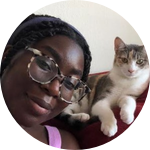About This Project
Those with chronic skin conditions are 2-6 times more likely to experience anxiety, depression, and physical discomfort. While chronic skin problems are generally colorblind, research and formulations that are generated to solve those problems shouldn't be. Therefore, there is a demonstrated need to formulate for chronic skin conditions such as hyperpigmentation, eczema, and keloids in dark skin while addressing the physiological and cultural difference of dark skin.
Ask the Scientists
Join The DiscussionWhat is the context of this research?
The Fitzpatrick Scale is a phenotypical skin classification system discovered in 1975 by American dermatologist Thomas B. Fitzpatrick. In the abstract that debuted the scale, Dr. Fitzpatrick writes that the system was initially constructed for assessing the photosensitivity of white skin types through criteria such as redness and burning. Since then, the scale has become the default clinical reference in studies and literature for classifying and treating skin conditions.
As we know, darker skin does not easily redden, and photosensitivity and skin conditions do not manifest identically to lighter skin. Therefore, skin research as we know it is presently classified by systems that do not adequately accommodate dark skin.
What is the significance of this project?
To put it plainly, there are not enough skin care solutions oriented and designed towards dark skin. While clinical research is presently being conducted to make up for this disparity, it is still not a frontline conversation among dermatologists and researchers.
Fortunately, body care solutions can be more easily crafted than facial treatments. This project is significant because its study design offers a chance to incubate research and innovation for formulating emulsions and active ingredient combinations that accommodate the physiological uniqueness of melanated skin. Additionally, a reconstructed 3D co-culture skin model will be used to determine results.
The data obtained from this project will contribute to future research in an under-studied area of dermatology.
What are the goals of the project?
The funds of this experiment will be used to purchase equipment, and conduct an in vitro experiment using a reconstructed tissue model.
Specifically, we will formulate the emulsions with active ingredients in concentrations and delivery systems crafted to best accommodate melanated skin types, culture a reconstructed in vitro dark-skinned MelanoDerm tissue model with the formulations (to reproduce how products will behave on actual skin), and measure and analyze rate of melanogenesis compared to a control.
Using this information, we will be able to confidently formulate skin products for dark skinned consumers that seek solutions for mildly chronic skin conditions such as sensitivity, eczema, and hyperpigmentation.
Budget
These budget items synergistically create a makeshift version of the typical lab formulation equipment: a homogenizer for mixing raw material and ensuring proper dispersion, the raw material themselves, pH meter for evaluation around neutral skin pH, labware (beakers, mixers, stirrers), and warehouse space. Besides the lab material themselves for formulation purposes, warehouse space and the tissue model are the most crucial budget items. A designated lab space would be essential to house and store all lab equipment, and also centralize all lab operations during and after the experiment. Similarly, the tissue model is extremely expensive, and is the main vehicle of evaluation in this experiment. This type of research is not performed often, as dark skin is not often thought of. However, it is an efficient approach to melanogenesis evaluation.
So far, a majority of these costs have been out of pocket (raw materials and shipping costs). Covering these costs would be a dream!
Endorsed by
 Project Timeline
Project Timeline
The timeline is broken down into four major milestones:
1. Acquisition of lab space and equipment.
2. Formulation of finalized products with active ingredients.
3. Incubate tissue model for three weeks.
4. Analyze data.
Jun 30, 2021
Project Launched
Jul 01, 2021
Acquire lab equipment (including tissue model) and glassware.
Jul 01, 2021
Acquire lab space.
Jul 14, 2021
Finish formulations of batches and induce tissue model.
Aug 04, 2021
Allow tissue model to incubate for 3 weeks.
Meet the Team
AJ Addae
Hi, I'm AJ!
I'm a 21 year old research scientist and writer on design, ethics, and culture. I'm also a recent graduate from Northeastern University with a degree in biology!
I'm most passionate about finding solutions for fellow dark skinned consumers. This is at the core of my research philosophy, as it is extremely understudied.
Despite being a Fulbright Fellowship finalist, an early college grad, and tbh a well experienced scientist, I used to suffer from a ton of impostor syndrome, as I didn't know if what I was doing was classified as "real research." However, what drives my passion for research is my incessant curiosity compared with my knack for creativity.
Thanks for reading! :)
Lab Notes
Nothing posted yet.
Additional Information
By deprioritizing this field of study, the skincare industry is actively harming communities of color, as skin cancer/diseases typically has a 67% survival rate for Black people, and a 92% survival rate for white people. This alone can be remedied by actively studying and accommodating the physiological landscape of dark skin. It is currently a largely untapped world.
Obviously, I am a dark skinned Black woman. :) My research background is situated in dermatological science, and I actually came across the discipline through observing that there was a lack of science that leverages clinical studies BY and FOR dark skin. Furthermore, STEM funding associations have historically not viewed this discipline a "real" scientific issue "issue" in science, as skincare is commonly seen as a cosmetic field.
When we look better, we feel better. It's why people wear makeup in the workplace no matter what job they do, and why the cosmeceutical industry is a multi-million dollar industry. Those with dark skin and chronic skin conditions deserve the same amount of cultural and scientific access to solutions that serve them well, and at an affordable price.
By funding this project, you are funding access to over the counter health care solutions for people of color, because skin care is health care.
Project Backers
- 13Backers
- 100%Funded
- $6,150Total Donations
- $473.08Average Donation

